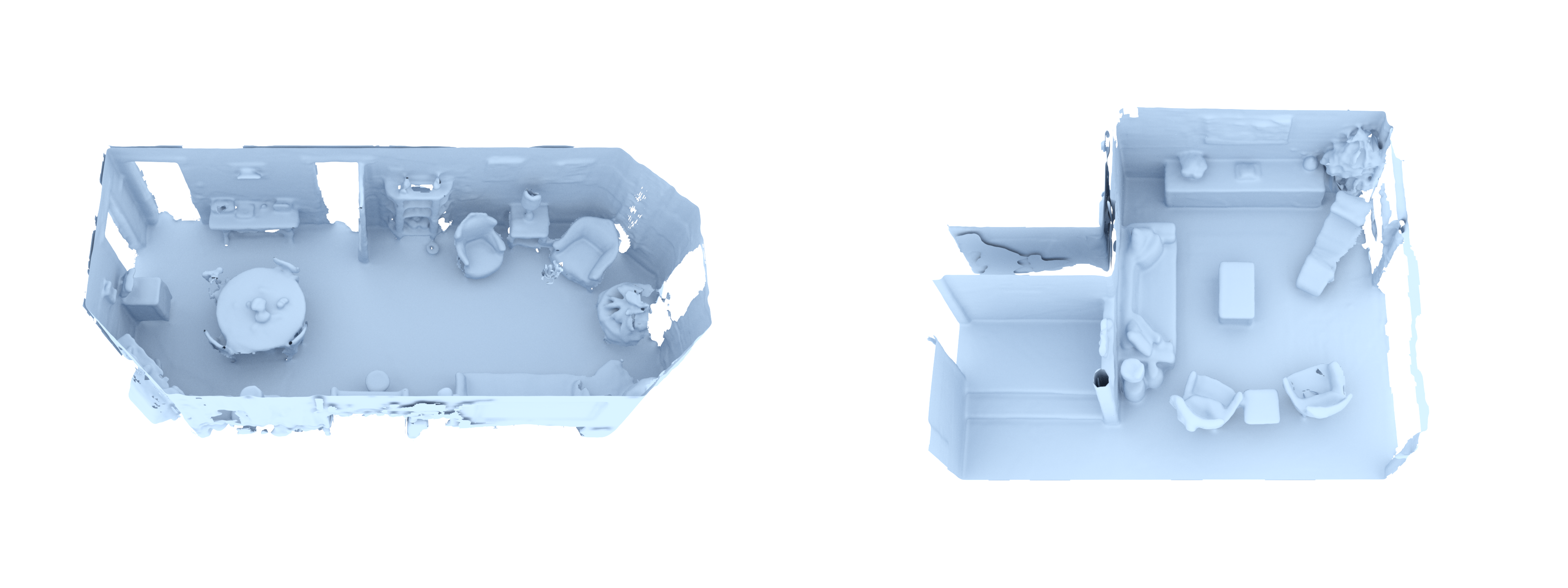Visualizes meshes, pointclouds and video flythroughs in publication quality
- Collection of scripts automating path-traced rendering with mitsuba (0.6.0), directly using their python API.
- Can also render flythroughs from predefined camera poses using bezier curves and catmull-rom splines
This implementation was used for the visualizations in Dai, Angela, Christian Diller, and Matthias Nießner. "SG-NN: Sparse Generative Neural Networks for Self-Supervised Scene Completion of RGB-D Scans." (CVPR'20)
You can find more samples, including flythroughs, in our SG-NN video.
- Install mitsuba 0.6.0, following the tutorial here: 10 Steps to Install Mitsuba Renderer on Ubuntu
- Clone this repository and install python dependencies:
git clone https://github.com/chrdiller/mitsuba-visualize
cd mitsuba-visualize
poetry install- After building mitsuba, adjust path in
set_python_path.pyto point to the folder you cloned mitsuba to (has to contain subdirectorydist/python)
MITSUBA_BASE = Path('/path/to/mitsuba/clone')Enter environment: poetry shell
- Meshes:
python mesh.py ...
usage: mesh.py [-h] -o OUTPUT [--scenes_list SCENES_LIST] [--scene SCENE]
[--cameras CAMERAS] [--width WIDTH] [--height HEIGHT]
[--samples SAMPLES] [--workers WORKERS]
[input_paths [input_paths ...]]
Render directory
positional arguments:
input_paths Path(s) to directory containing all files to render
optional arguments:
-h, --help show this help message and exit
-o OUTPUT, --output OUTPUT
Path to write renderings to
--scenes_list SCENES_LIST
Path to file containing filenames to render in base
path
--scene SCENE One scene. Overrides scenes_list
--cameras CAMERAS XML file containing meshlab cameras
--width WIDTH Width of the resulting image
--height HEIGHT Height of the resulting image
--samples SAMPLES Number of integrator samples per pixel
--workers WORKERS How many concurrent workers to use- Point Clouds:
python pointcloud.py ...
usage: Render pointcloud with mitsuba by placing little spheres at the points' positions
[-h] -o OUTPUT [--radius RADIUS] [--width WIDTH] [--height HEIGHT]
[--samples SAMPLES] [--workers WORKERS]
input [input ...]
positional arguments:
input Path(s) to the ply file(s) containing a pointcloud(s)
to render
optional arguments:
-h, --help show this help message and exit
-o OUTPUT, --output OUTPUT
Path to write renderings to
--radius RADIUS Radius of a single point
--width WIDTH Width of the resulting image
--height HEIGHT Height of the resulting image
--samples SAMPLES Number of integrator samples per pixel
--workers WORKERS How many concurrent workers to useAs in the SG-NN video
- (Optional) Export cameras from meshlab
- Open the mesh in meshlab and press
Cmd/Ctrl + Cto copy the current camera view - Paste into a text editor (will be a few lines of XML)
- Save as xml file
- Repeat for every camera keypoint
- Open the mesh in meshlab and press
- (Alternatively) Do not specify cameras; this will render a slightly tilted top-down turntable view
- Usage:
python flythough.py ...
usage: Render a flythrough video of a scene [-h] -o OUTPUT
[--remote [REMOTE [REMOTE ...]]]
[--novideo] [--norender] [--keep]
[--scenes_list SCENES_LIST]
[--frames FRAMES]
[--cameras CAMERAS]
[--shutter_time SHUTTER_TIME]
[--width WIDTH] [--height HEIGHT]
[--fov FOV] [--samples SAMPLES]
[--interpolation {catmullrom,bezier}]
[--workers WORKERS]
input [input ...]
positional arguments:
input Path to the ply file to render
optional arguments:
-h, --help show this help message and exit
-o OUTPUT, --output OUTPUT
Path to write output video to
--remote [REMOTE [REMOTE ...]]
Urls of the remote render servers
--novideo Only render frames, do not produce video
--norender Only render video from existing frames, no rendering
--keep Whether to keep the frame images
--scenes_list SCENES_LIST
Path to file containing filenames to render in base
path
--frames FRAMES Number of frames to render (The video file will have
30fps)
--cameras CAMERAS XML file containing meshlab cameras (or path to
directory only containing such files). If set, this is
used for spline interpolation. Otherwise, a rotating
flyover is generated
--shutter_time SHUTTER_TIME
Shutter time of the moving sensor
--width WIDTH Width of the resulting image
--height HEIGHT Height of the resulting image
--fov FOV Field of view of the sensor in degrees (meshlab
default is 60)
--samples SAMPLES Number of integrator samples per pixel
--interpolation {catmullrom,bezier}
Which method to use for interpolation between control
points
--workers WORKERS How many local concurrent workers to use